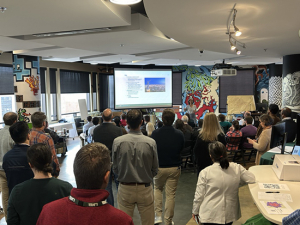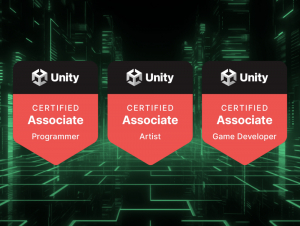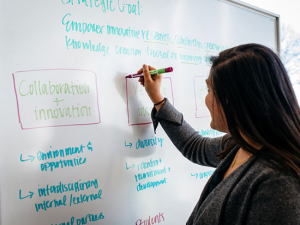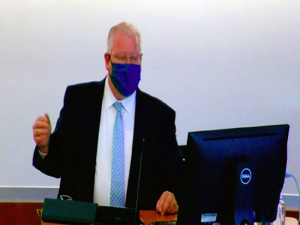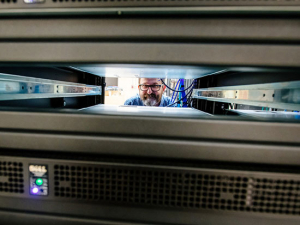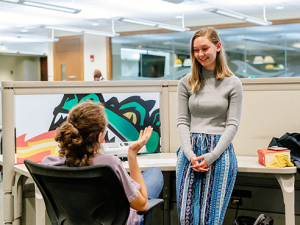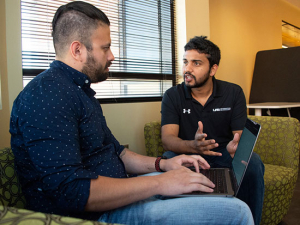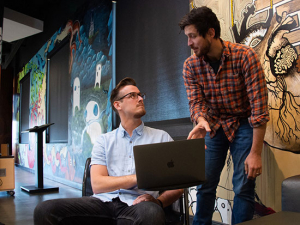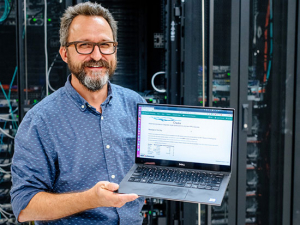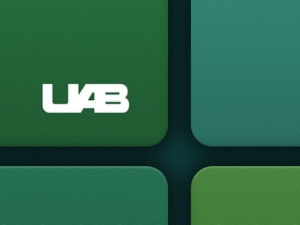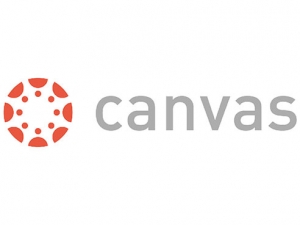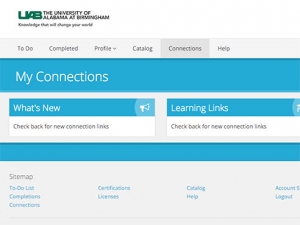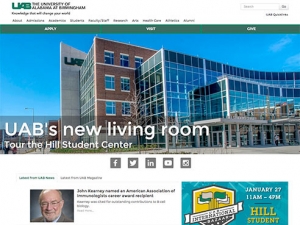 Since joining UAB in June as vice president and chief information officer, Curtis Carver Jr., Ph.D., has been on a whirlwind mission to spur development of a transparent, high-performing central IT organization with a culture of providing world-class customer service and implementing agile, cost-effective and innovative technologies.
Since joining UAB in June as vice president and chief information officer, Curtis Carver Jr., Ph.D., has been on a whirlwind mission to spur development of a transparent, high-performing central IT organization with a culture of providing world-class customer service and implementing agile, cost-effective and innovative technologies.
Carver’s goal is to achieve “100 wins” that improve the work experiences of faculty, staff and students in his first year, and he’s off to a great start with a plan to listen intently and act intentionally.
“A world-class university needs a world-class IT organization to support it,” Carver said. The plan to accomplish that is set out in seven strategic imperatives (see box below).
Light a SPARK
Central to this is the new crowdsourcing platform, SPARK, which has collected more than 70 new ideas and more than 2,000 votes from users throughout campus since it launched in June. Anyone with a BlazerID can use the forum to propose new projects or efficiencies or improvements to existing ones. Those suggestions can generate comments and be voted up or down by campus users.
“The SPARK platform allows us to crowdsource innovation,” Carver said. “This is an opportunity for you to share your ideas and for us to align those ideas with the needs of the university.”
One of the first quick wins was the SPARK-inspired idea to double the size limit for files sent via the UAB Dropbox. File sizes can now be as large as 4Gb.
Working together for UAB
Improving processes begins by rethinking the ways services are provided to customers, Carver said. As part of a departmentwide campaign to reThink service, UAB IT is working to improve its methods and also its mindset toward customer service.
With the help of an industry-leading ServiceNow tool for management, UAB IT will create one portal into IT, which will make it easier for users to locate and access products and request services and support. Engagement with the community on the new tool is underway in preparation for its launch to campus users in January 2016. The new tool will replace multiple applications now in use.
UAB IT also is removing barriers to cooperation across a complex organization, partnering with distributed information technology professionals in units throughout campus. Distributed IT employees have a welcome place at the table as UAB IT employees work to improve their processes, and a shared governance structure will help UAB IT better align its capabilities with computing and technology needs throughout the university.
In his first 90 days at UAB, he has already hosted three town hall meetings and a number of lunchtime technology meetings to engage the community. UAB IT also is publishing a monthly IT Update, with news and announcements about technology projects.
Equally important is strengthening the university’s partnership with UAB’s Health System Information Services (HSIS), which will enable the university to continue to share infrastructure and collaborate in areas such as security to ensure seamless protection across campus.
A recent investment is in Apptio, a software tool that is a leader in technology business management, to support UAB IT’s financial transparency and accountability project. The project will enable UAB IT to provide information around the cost of IT operations so the university can make data-driven decisions.
Early successes
UAB has realized some early successes in high-performance computing. This includes quadrupling the research computing speeds through President Ray Watts’ strategic investment; winning an Alabama Innovation Fund grant to quadruple UAB’s research storage to three petabytes; and winning a National Science Foundation grant to create a separate on-campus network with an associated Science DMZ that should increase research network speeds tenfold.
Working with the Office of the Senior Vice Provost and the Faculty Affairs Committee, UAB IT is implementing a new online faculty recruitment system using PeopleAdmin technology. In addition, UAB IT will help accelerate and automate faculty onboarding into UAB IT systems such as BlazerID, Banner and Canvas.
A new online tool for faculty will enable them to manage their professional information, including publications, grants data and other teaching and professional activities. Some schools have been trained on the Faculty Profiles system, and it is being rolled out to the rest of campus this fall.
UAB IT also has negotiated a contract with Box, which would allow unlimited cloud storage for faculty and staff in a secure environment that meets or exceeds university and legal requirements for privacy. Beta testing is expected to begin in October.
Robust technology infrastructure is a foundation for IT services. UAB IT is refreshing servers, upgrading the network and data center and expanding our wireless communications network and telephone system to meet the needs of UAB’s constituents.
Even now a new fiber hub project is underway that will help protect network traffic with redundant fiber cable infrastructure, and a telephone project is relocating phone services to a network-based infrastructure, which will be more flexible for campus needs.
Protect information assets
Last, but by no means least, is the protection of UAB’s information assets from threats posed by systems failure, unwanted access or natural or man-made disaster. These assets include core business-processing systems such as the Oracle financial and human resources system, the Banner student information system and the InfoEd research administration system, along with clinical and research systems located in schools and departments. UAB has redundancies to protect information but is also moving to redundant offsite capabilities for the full recovery of all critical management systems.
Projects are also underway to ensure proper management and protection of all physical technology and data with the use of enterprise patch-management tools.
In addition, UAB IT is building a new security infrastructure for identity management, which will replace the system that supports access to UAB programs with a more robust central authentication service. UAB is also changing its password/passphrase policy to better protect UAB assets. Beginning Sept. 15, the policy will require passwords to be 15 characters, but they will expire after one year. The policy will implemented in phases.
The initiatives under way by UAB IT will help support the needs of a world-class university.
“UAB IT is moving at the speed of trust and picking up speed,” Carver said.
Progress on the department’s 100 technology wins for UAB will be shared on the UAB IT website, www.uab.edu/it, and in the UAB Reporter.
UAB IT guided by seven strategic imperatives:
|


